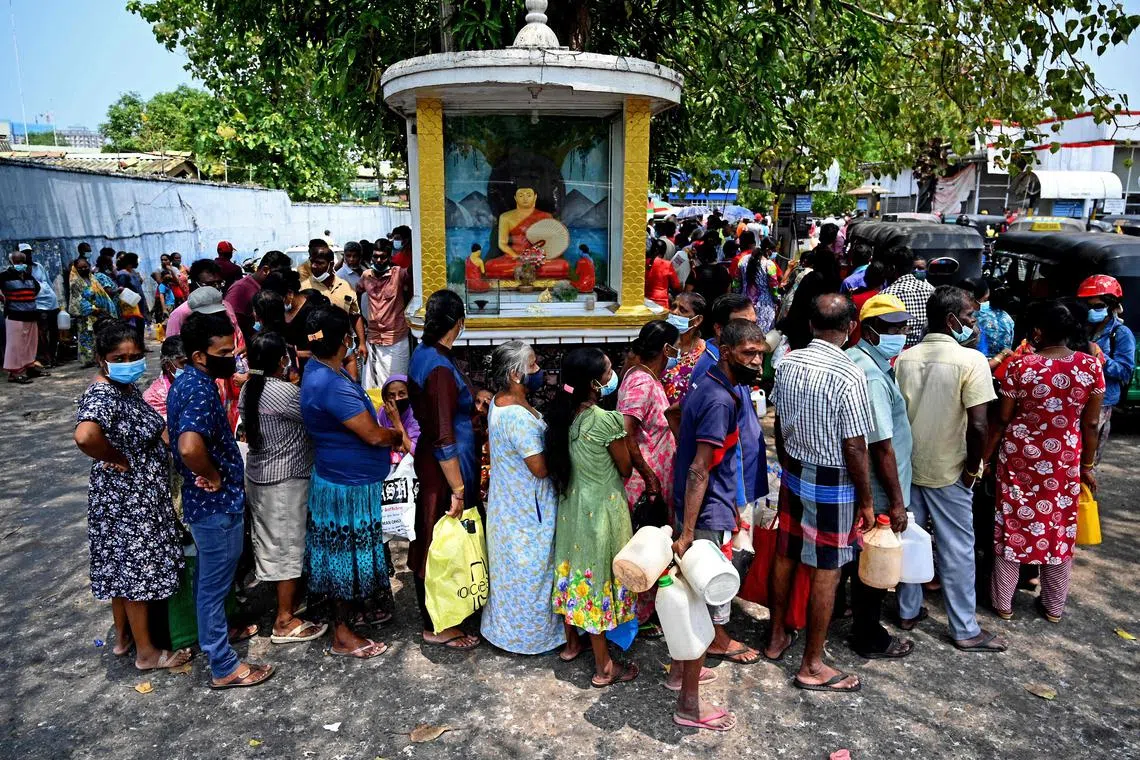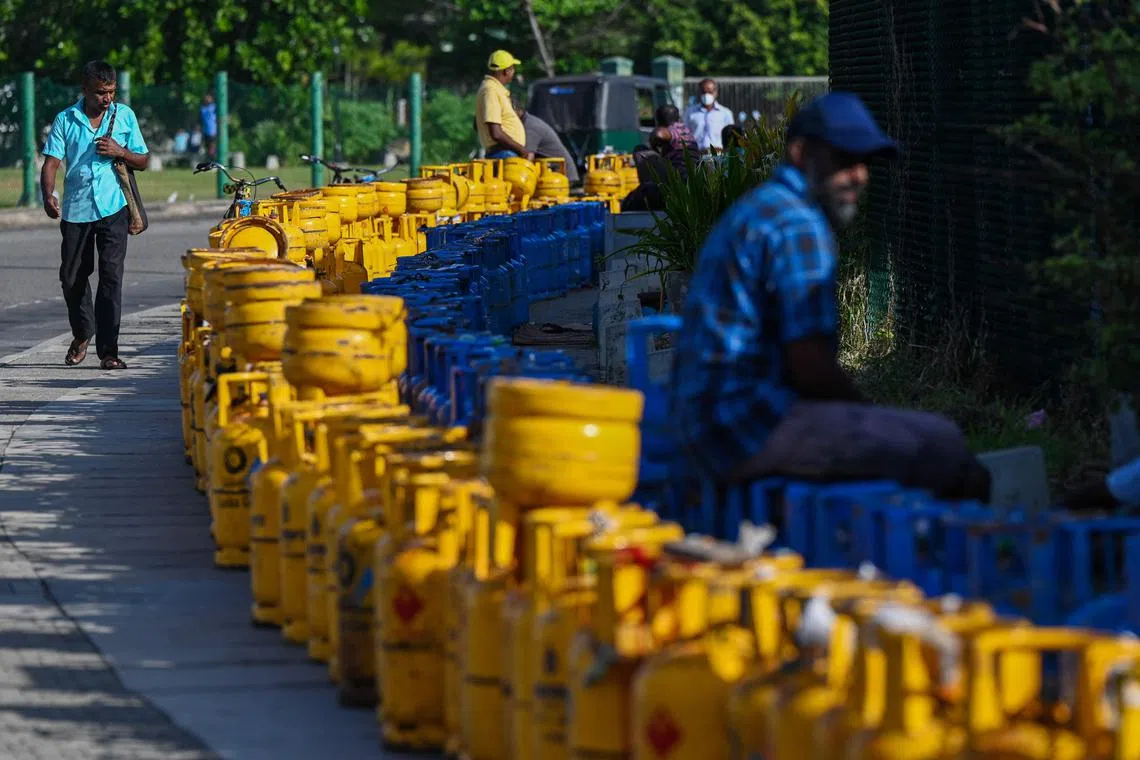A year later, Sri Lanka’s tentative economic recovery eludes the poor
Sign up now: Get ST's newsletters delivered to your inbox

People queueing to buy kerosene oil for home use at a petrol station in Colombo on March 25, 2022.
PHOTO: AFP
Follow topic:
COLOMBO – A year after angry Sri Lankans stormed the then President’s residence
The central bank expects the economy to resume growth this quarter after six quarters of contraction – faster than expected by many economists – while overseas remittances are surging and tourist numbers are rising.
While economists judge the country to be past the worst of the crisis, its problems are far from fixed.
Food, healthcare and house rental costs are high and still increasing, the poverty rate has doubled in the last year and is seen rising further, while negotiations to reorganise the government’s crippling debt burden face some uncertainty.
“Stability is somewhat there but what it means is no extreme shortages, no fuel queues and no 13-hour power cuts,” said Ms Rehana Thowfeek, an economist at the Colombo-based Advocata Institute think-tank.
“Inflation is tapering off but compared with pre-crisis levels, the cost of living is very high and incomes have not kept up. The bulk of Sri Lanka’s poor people are daily wage earners, and they are among the hardest hit.”
Sri Lanka sank into a financial crisis after the Covid-19 pandemic decimated tourism and remittances from citizens working abroad fell.
The war in Ukraine
In March 2022, thousands took to the streets to vent their anger
After weeks of protests and a steady worsening of the crisis, then President Gotabaya Rajapaksa fled overseas, formally stepping down on July 13, 2022.
He was replaced as president by his prime minister, Mr Ranil Wickremesinghe, bailout from the International Monetary Fund (IMF) in March.
While price increases are easing, prices are still high.
Power costs, which jumped 65 per cent in February, remain difficult for low-income families to cope with despite a 14.2 per cent reduction in July.
The key inflation index was at 12 per cent in June and is expected to hit single digits in July after peaking at 70 per cent in September 2022 and following a rebasing in February 2023.
But food, clothing, healthcare and housing costs remain elevated.
Food inflation hit a record high of 95 per cent in September 2022, and although it has come down, June’s reading of 4.1 per cent means prices are still rising.
Clothing prices increased 44 per cent year on year in June, housing 26 per cent and medical costs 16 per cent.
Rising costs affect poverty levels, which nearly doubled to 25 per cent of the population in 2022 and could jump to 27.4 per cent in 2023, according to the World Bank.
Last week, the multilateral lender to developing countries approved a US$700 million loan for Sri Lanka, including US$200 million for the poor.
Lots to do
In a new initiative to help the poor, the government has said it will roll out a direct cash transfer programme to about 2.3 million families later in July and pledged to spend US$680 million a year on their welfare.
But critics say the monthly handout of 2,500 rupees (S$11) to 15,000 rupees, based on poverty levels, is inadequate.
Mr Kamal Padmasiri, a board member of the state-run Welfare Benefits Board, estimated the requirement at 13,800 rupees per person per month, but said the Exchequer cannot pay the whole amount.
“We are in a default situation in Sri Lanka,” he told Reuters. “Cash transfers will be given for three years and people need to develop and move forward during this time. The payments are not permanent... We cannot afford it.”
There have been some gains, however.
A 30 per cent rise in tourism revenues in 2023 and a 76 per cent jump in remittances have funnelled US$3.2 billion into Sri Lanka’s coffers, helping reserves hit a 14-month high of US$3.5 billion in May, and the currency appreciate by about 18 per cent in 2023.

Liquefied petroleum gas cylinders for sale to residents near the Galle International Cricket Stadium on June 28, 2022.
PHOTO: AFP
Sri Lanka still must rework a large chunk of its US$36 billion foreign debt, which includes US$12.5 billion in international sovereign bonds and US$11.3 billion bilateral credit owed mostly to China, Japan and India.
Mr Wickremesinghe has set a goal of finalising debt talks by September, which, if successful, would smooth the release of a second tranche of IMF funding due by October.
But China, Sri Lanka’s largest bilateral lender with about US$7.4 billion in outstanding bilateral and commercial loans, has so far declined to join a so-called common framework led by Japan and the Paris Club of creditor nations to renegotiate Sri Lanka’s debt.
Also, despite the projection of growth starting in the July quarter, Sri Lanka’s export-driven economy is expected to contract by 2 per cent in the full year, after shrinking 7.8 per cent in 2022.
Exports fell 11 per cent in 2023 until May, mostly driven by a 16.5 per cent drop in garment sales to the European Union and the United States.
“We really need our exports to accelerate, we need genuine investors coming in, and we need to take forward market access through free-trade agreements and other measures,” said Mr Shiran Fernando, chief economist at Sri Lanka’s largest industry body, the Ceylon Chamber of Commerce.
“The IMF programme will keep us going only for the next one to two years, but beyond that, we need stronger reforms around land, labour and loss-making state enterprises.” REUTERS

